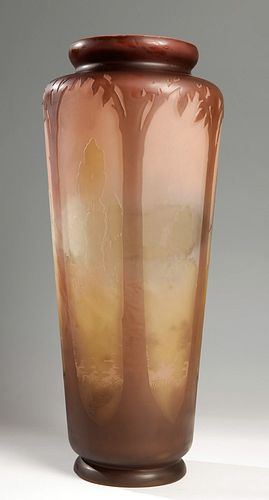Art Nouveau vase by GALLÉ; France, ca. 1910. Original period piece. Acid-etched cameo glass. With frame.
Lot 12
About Seller
Setdart Auction House
Carrer Aragó 346
Barcelona
Spain
Setdart Subastas was born in 2004 and is currently the first online art auction in Spain with solidity, prestige and reliability guaranteed by our more than 60,000 users. Setdart has a young, dynamic and enterprising team ready to successfully manage the purchase and sale of art works through custom...Read more
Categories
Estimate:
EUR€1,800 - EUR€2,000
$1,935.48 - $2,150.54
Absentee vs Live bid
Two ways to bid:
- Leave a max absentee bid and the platform will bid on your behalf up to your maximum bid during the live auction.
- Bid live during the auction and your bids will be submitted real-time to the auctioneer.
Bid Increments
| Price | Bid Increment |
|---|---|
| EUR€0 | EUR€10 |
| EUR€200 | EUR€25 |
| EUR€500 | EUR€50 |
| EUR€1,000 | EUR€100 |
| EUR€3,000 | EUR€200 |
| EUR€5,000 | EUR€500 |
| EUR€10,000 | EUR€1,000 |
| EUR€20,000 | EUR€2,000 |
| EUR€50,000 | EUR€5,000 |
About Auction
By Setdart Auction House
Oct 27, 2021
Set Reminder
2021-10-27 10:00:00
2021-10-27 10:00:00
America/New_York
Bidsquare
Bidsquare : 19th & 20th Century Paintings & Decorative Arts
https://www.bidsquare.com/auctions/setdart-auction-house/19th-20th-century-paintings-decorative-arts-7767
Setdart Auction House sofia@setdart.com
Setdart Auction House sofia@setdart.com
- Lot Description
Art Nouveau vase by GALLÉ; France, ca. 1910. Original period piece. Acid-etched cameo glass. With frame. Measurements: 49 x 21 cm. Vase of classical stylized typology, with circular flat foot, narrower than the tank, inverted truncated cone body with rounded shoulders and wide and low mouth, convex profile. It is composed of three layers of glass, the lower translucent, pink with white clouds, the intermediate light green and brown glass top, the latter two lowered at different levels to obtain a wide range of shades that provide three-dimensionality to the motifs and reinforce the construction of the space represented, organized in two planes of depth. The design presents us with a landscape dominated by stylized trees in the foreground, behind which we can see the banks of a river, whose calm waters reflect the tops of the trees on the opposite bank, whose forms are blurred by the mist, magnificently achieved. Émile Gallé began his career working for his father, who owned a glass and ceramics factory, making designs with floral and heraldic motifs. Very interested in botany, he studied it in depth during his youth, alternating with drawing classes. Between 1862 and 1864, at his father's request, he traveled through Italy, England and Germany, becoming interested in the applied arts but also in subjects that he would later reflect in his works, such as music, philosophy and nature. On his return, he settled in Meisenthal, where the glass furnaces of his family were, in order to fully learn the craft of glassmaker. He also traveled to London and Paris to see the collections of their museums. In 1874 he took over his father's factory, and soon achieved great international success, winning awards at international exhibitions and selling works to major collections and museums. In 1878 he presented his first creations at the Universal Exhibition in Paris, many of which were inspired by the Japanese artists Hokusai (1760-1849) and Hokkei (1780-1856). In this important exhibition, Gallé will discover three techniques that will prove decisive for his production: the remarques of the Pantin Glassworks, the cameo engraved glasses of the English (which are inspired by the Portland Glass of the British Museum) and the superposition of layers of glass of different colors presented by Eugène Rousseau. Undoubtedly, Émile Gallé was a man fully representative of his time. He was a poet, an artist par excellence, able to translate into matter his emotions and longings, someone who found in the alchemy of glass, in its light, in its nuances, a form of language. Because of this talent and his mastery, his glassworks would be the most famous in France around 1900. He was, moreover, founder and president of the Nancy School, whose principles he always followed. He introduced in his pieces all kinds of experimental and innovative techniques, as well as some traditional ones. One of them was the introduction of metal sheets between the different layers of glass, thus enhancing the magical effect of his most exclusive pieces. As far as possible, Gallé imposed the characteristics of a style that evolved into free and refined expressions, applying a huge variety of themes and decorative techniques on opaque and colored glass, which continue to amaze today. Currently you can see pieces made by Emile Gallé in the Hermitage Museum in St. Petersburg, the Metropolitan Museum in New York, the Orsay Museum in Paris, the Brohan Museum in Berlin and the Victoria & Albert Museum in London, among many others. Regarding the technique, in fact the cameo glass is known since ancient times, although it was taken up again in the late nineteenth century in France and England. Gallé presented his technique of acid cameo at the Paris Exhibition of 1889, with the aim of bringing modernist glass to the public.
- Shipping Info
-
In-house shipping available. Please inquire at admin@setdart.com.
-
- Buyer's Premium



 EUR
EUR CAD
CAD AUD
AUD GBP
GBP MXN
MXN HKD
HKD CNY
CNY MYR
MYR SEK
SEK SGD
SGD CHF
CHF THB
THB














